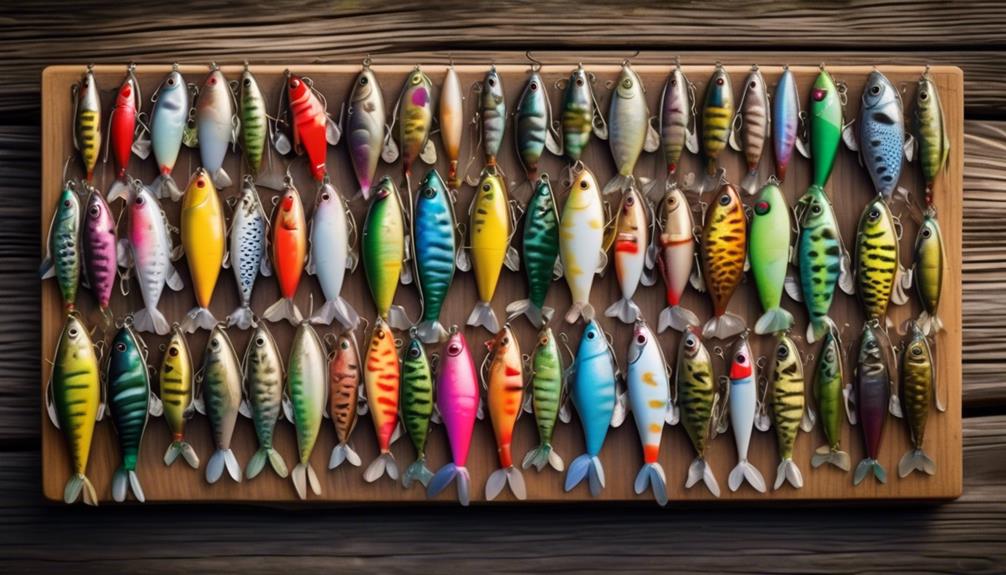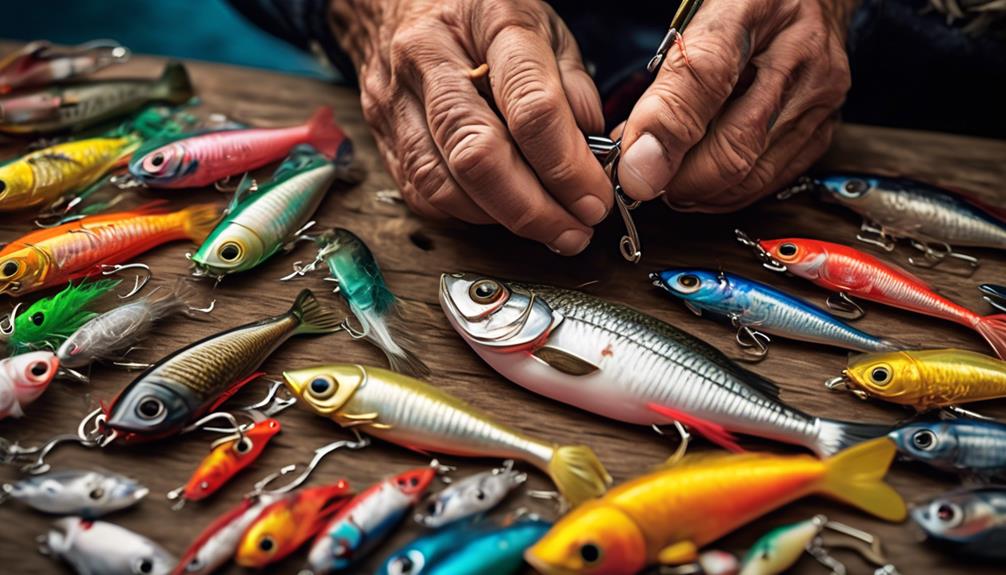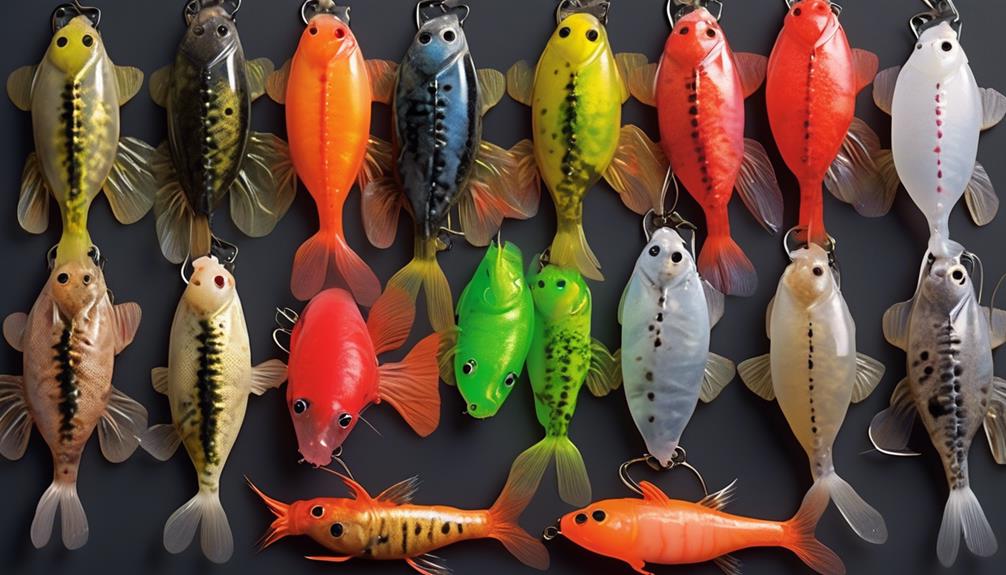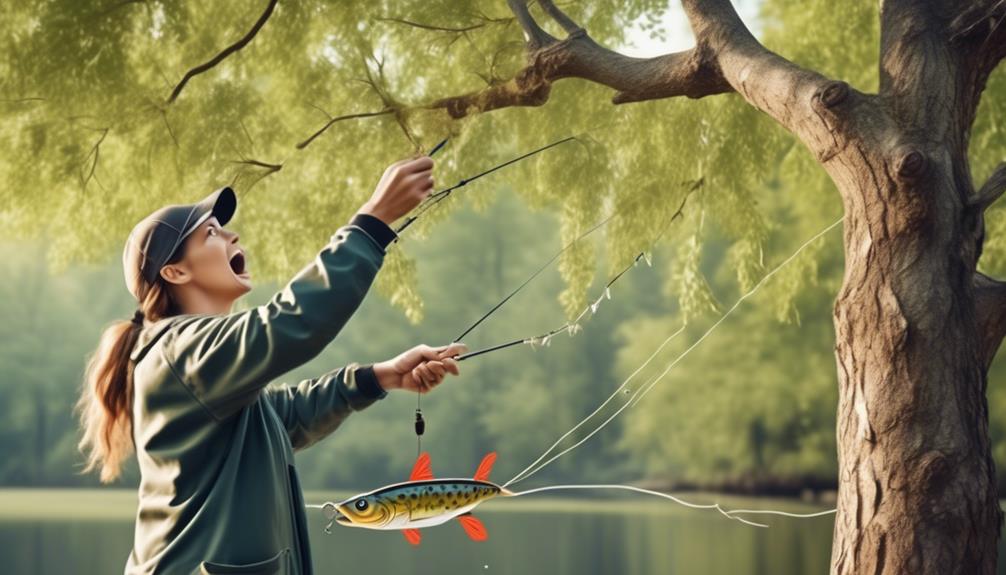If you're an angler who loves fishing in local ponds, you're part of a significant group – over 46 million people in the United States enjoy the activity. When it comes to maximizing your success, the right lures can make all the difference. You might be surprised to learn that the top 7 local pond fishing lures can vary greatly depending on the specific conditions and the type of fish you're targeting.
So, which lures should you be considering for your next pond fishing adventure? Let's explore the top 7 local pond fishing lures that could help you reel in the big one.
Topwater Frog Lures
When targeting bass in shallow water, topwater frog lures can be your go-to choice for an exciting and effective fishing experience. These lures are designed to mimic the movement of a frog, which is a favorite meal for bass. To maximize your success with topwater frog lures, it's crucial to master the retrieval techniques and understand how seasonal variations and color selection can impact their effectiveness.
In shallow water with weed cover, using a walking or popping retrieve can be highly effective with topwater frog lures. The walking retrieve involves a side-to-side motion, imitating a frog darting across the surface. On the other hand, the popping retrieve involves a series of quick jerks, creating a splashing sound that can attract bass hiding in weed cover. By alternating between these techniques, you can entice strikes from bass lurking in shallow, weedy areas.
Seasonal variations and color selection also play a significant role in the success of topwater frog lures. During the warmer months, when bass are more active and often positioned closer to the surface, brighter and bolder colored frog lures can be more effective in grabbing their attention. In contrast, during colder months or in heavily pressured waters, opting for more natural and subdued colors can yield better results.
Spinnerbait
If you're looking for a versatile and effective lure for targeting bass in a variety of water conditions, spinnerbait can be a reliable choice. Spinnerbaits are known for their ability to cover water quickly and attract aggressive strikes from bass. When using spinnerbaits, it's essential to understand the proper techniques and the best spinnerbait colors to maximize your chances of success.
- Retrieve Speed: Vary your retrieve speed to find out what the bass are responding to on any given day. Sometimes a slow, steady retrieve works best, while other times a fast, erratic retrieve can trigger strikes.
- Blade Combinations: Experiment with different blade combinations such as willow leaf, Colorado, and Indiana blades to see which ones the bass prefer. Each blade type produces a different vibration and flash, so having a variety in your tackle box can be beneficial.
- Target Structure: Cast your spinnerbait around any visible cover or structure, such as docks, fallen trees, or weed beds. The erratic movement of a spinnerbait can entice bass hiding in these areas to strike.
- Best Spinnerbait Colors: In clearer water, natural colors like shad, chartreuse, and white can be effective. In murky or stained water, darker colors such as black, blue, and purple tend to work better.
- Trailer Hooks: Consider using spinnerbaits with trailer hooks to increase your hookup ratio, especially when bass are striking short.
Crankbait
As you switch from using spinnerbaits to considering crankbaits, you'll find a different approach to targeting bass in various water conditions with this versatile lure. When it comes to crankbait retrieval techniques, you'll want to experiment with different speeds and pauses to find what works best for the local pond bass. Vary your retrieval speed by cranking the handle at different paces, and intermittently pause to allow the crankbait to suspend or rise slightly before continuing. This erratic movement often triggers strikes from nearby bass.
For local ponds, the best colors for crankbaits often include natural patterns such as shad, perch, or bluegill imitations. These colors tend to mimic the local forage and can increase your chances of attracting strikes. In terms of crankbait rod and reel setups, a medium to medium-heavy power rod paired with a high-speed baitcasting reel is a popular choice. The stiffness of the rod helps in providing the necessary backbone for hook sets, while the high-speed reel allows for quick retrieval and better control over the crankbait's depth.
Some popular local pond crankbait brands include Rapala, Strike King, and Berkley. These brands offer a variety of crankbait styles and colors suitable for different water conditions and bass behavior. When using crankbaits in local ponds, it's essential to adapt to the specific environment and the behavior of the bass.
Soft Plastic Worms
Experiment with different soft plastic worm sizes and colors to find what works best for enticing bass in your local pond. When it comes to fishing with soft plastic worms, the right technique can make all the difference. Here are some key pointers to keep in mind:
- Fishing Technique: Slow and steady retrieves often work best with soft plastic worms. The lifelike movement of the worm as it glides through the water can trigger a bass's predatory instincts. Try using a Texas rig or Carolina rig for optimal presentation and to prevent snagging on underwater debris.
- Soft Plastic Colors: The color of your soft plastic worm can play a significant role in attracting bass. In clearer waters, natural colors like green pumpkin, watermelon, and black are effective choices. When the water is murky or dark, consider using brighter colors such as chartreuse, pink, or even bold red to enhance visibility.
- Tail Action: Pay attention to the action of the worm's tail. Some soft plastic worms have curly or paddle tails that create enticing movement in the water, while others have straight tails for a more subtle approach. Experiment with different tail designs to see which ones elicit the best response from the bass in your local pond.
- Scented Options: Some soft plastic worms come infused with scents that can entice bass to strike. Garlic, anise, and shad are popular scents that can add an extra layer of attraction to your soft plastic presentation.
- Size Matters: Varying the size of your soft plastic worms can be crucial. Smaller worms around 4-5 inches are great for finesse fishing, while larger 7-10 inch worms can mimic bigger prey and trigger larger bass to strike.
Jigging Spoon
When fishing with a jigging spoon, remember to vary your retrieval speed to entice different species of fish at varying depths. Jigging spoon techniques can be highly effective for catching fish in local ponds. By using a jigging motion to mimic injured baitfish, you can attract the attention of predatory fish such as bass, pike, and walleye. It's important to experiment with different jigging motions, including short and sharp jerks or slower and subtler movements, to see what works best on any given day.
Several reputable brands offer high-quality jigging spoons designed to maximize your fishing success. Look for well-known names such as Johnson, Acme, and Hopkins, as they're trusted for their durable, well-designed spoons that can withstand the rigors of pond fishing. These brands often offer a variety of sizes and colors to cater to different fishing conditions and the preferences of various fish species.
When considering the effectiveness of jigging spoon versus live bait, it's essential to recognize that both can be successful in different situations. Jigging spoons offer the advantage of covering more water efficiently and can be particularly effective for locating active fish. Live bait, on the other hand, can be more enticing to certain species and can be especially useful when fish are less active. Ultimately, incorporating both techniques into your fishing arsenal can maximize your chances of success on any given day.
Jerkbait
To maximize your success in local pond fishing, incorporating a variety of lures such as jerkbaits can help you target different species and adapt to the ever-changing behavior of the fish.
When using jerkbaits, it's important to consider various factors such as the retrieval techniques, color selection, and rigging options to increase your chances of a successful catch.
- Jerkbait Retrieval Techniques: Vary your retrieval speed to imitate injured baitfish, as this erratic movement can trigger aggressive strikes from predatory fish.
- Best Local Pond Spots for Using Jerkbaits: Target areas with submerged vegetation, near drop-offs, and around structure like docks or overhanging trees to entice fish hiding in these spots.
- Jerkbait Color Selection: Choose natural colors such as shad, bluegill, or perch patterns for clear water, and opt for brighter or more contrasting colors like chartreuse or orange for murky water conditions.
- Jerkbait Rigging Options: Experiment with different rigging styles, such as using weighted hooks for deeper presentations or adding a split ring to allow the bait more freedom of movement.
Inline Spinner

Consider using an inline spinner as an effective lure for targeting active fish in local ponds, especially in areas with shallow water or moderate vegetation. Inline spinners are versatile and can be used with various fishing techniques such as casting, trolling, and retrieving.
When fishing in local pond hotspots like weedy areas or near the shore, the inline spinner's design allows it to move through the water with an enticing spinning action, attracting the attention of predatory fish.
One of the key advantages of using an inline spinner in local ponds is its ability to mimic small baitfish or insects, making it a go-to lure for targeting species like bass, trout, and panfish. The flash and vibration produced by the spinning blade of the inline spinner effectively grab the attention of fish in these confined waters, increasing your chances of a successful catch.
When fishing with an inline spinner in local ponds, it's essential to vary your retrieval speed and depth to find what works best on any given day. Try casting the inline spinner towards areas with submerged structure or along the edges of weed beds, and experiment with different retrieval speeds to see what entices the fish to strike.
Swimbaits
Swimbaits are effective lures for targeting larger fish species in local ponds, enticing them with realistic swimming actions and lifelike appearances. When it comes to bass fishing, swimbaits can be particularly effective for enticing trophy-sized bass. Here are some tips and techniques for using swimbaits effectively:
- Select the Right Size: Choose swimbaits that closely match the size of the local forage fish. This will help in mimicking the natural prey and enticing the bass to strike.
- Retrieve Speed: Experiment with different retrieval speeds. A steady, slow retrieve can mimic the movement of injured baitfish, while a faster retrieve can trigger a reaction strike from aggressive bass.
- Use Weedless Options: Opt for weedless swimbaits when fishing in areas with heavy vegetation. This will allow you to fish in areas where bass are likely to be lurking without getting snagged.
- Vary Depths: Swimbaits can be fished at different depths by adjusting the weight of the lure or using different retrieval techniques. This versatility allows you to target bass at various depths within the pond.
- Pair with Quality Gear: Use a medium to medium-heavy rod and a baitcasting reel to effectively cast and retrieve swimbaits. The right gear can make a significant difference in your success with swimbaits.
Frequently Asked Questions
What Are the Best Types of Local Ponds to Fish With Each of These Lures?
For the best lures, deep ponds are ideal for targeting larger fish. When casting, aim for areas with submerged structures or drop-offs.
In clear ponds, use natural-looking lures to mimic local baitfish. Vary your retrieval speed and experiment with different techniques to find what works best.
Keep in mind that each pond may have its own unique characteristics, so be open to adjusting your approach based on the specific conditions.
Are There Any Specific Techniques or Tips for Using These Lures in Shallow Ponds?
When fishing in shallow ponds, using topwater lures can be effective. Cast near the shore and retrieve slowly to mimic natural movement. Try using a stop-and-go retrieve to entice strikes.
Pay attention to the water's surface and look for any signs of fish activity. Experiment with different movements and speeds to see what works best.
Remember to be patient and observant when fishing in shallow water to maximize your chances of success.
How Do Environmental Factors Such as Water Temperature and Clarity Affect the Effectiveness of These Lures in Local Ponds?
In local ponds, environmental factors like water temperature and clarity can greatly impact the effectiveness of lures.
In murky water, bright, high-contrast lures work best.
Warmer weather can increase fish activity, while cold fronts can slow things down.
When the water is clear, natural-looking lures tend to be more effective.
Pay attention to these factors and adjust your lure choice and fishing technique accordingly for better success in local pond fishing.
Can These Lures Be Used Effectively in Small, Heavily Vegetated Ponds?
In small, heavily vegetated ponds, these lures can be effective if you adjust your lure retrieval and vegetation management. To navigate the thick vegetation, try using topwater lures or weedless designs to prevent snagging.
Vary your retrieval speed and pause to mimic injured prey, enticing strikes. Experiment with different lures to find what works best in your local pond's conditions.
With the right approach, you can definitely use these lures effectively in such environments.
Are There Any Specific Color or Size Recommendations for These Lures When Fishing in Local Ponds?
When fishing in local ponds, specific color recommendations for lures depend on water clarity and time of day. For clear water, go for natural colors like green pumpkin or watermelon. In murky water, try brighter colors like chartreuse or orange.
Size recommendations also vary – smaller lures work well for finicky fish, while larger lures can attract bigger bites. Experiment with different colors and sizes to see what works best in your area.
Conclusion
So, next time you're heading out to your local pond for some fishing, make sure to pack a variety of lures to cover all your bases.
From topwater frog lures to swimbaits, there are plenty of options to entice those fish.
Experiment with different lures and techniques to see what works best for you.
Happy fishing!



